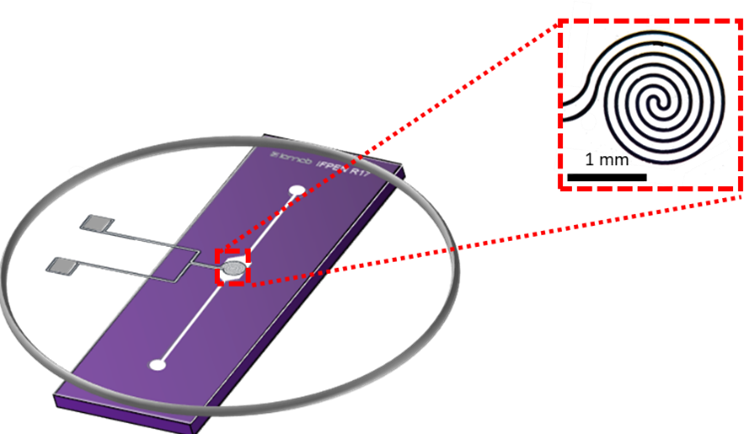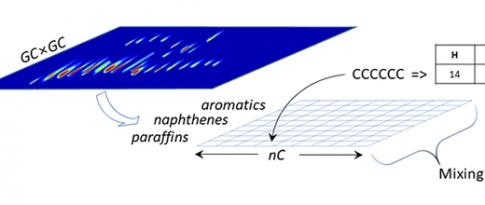18.03.2024
3 minutes of reading
Thermal conductivity is a key property for the dimensioning of numerous types of equipment, such as exchangers used to transfer thermal energy from one heat-carrying fluid to another, without mixing them. Thesis work conducted at IFPEN [1] is challenging the approaches traditionally employed for both measuring and predicting this property.
Microfluidics: the experimental approach
Microfluidics is a technique that consists in studying the behavior of fluids in miniaturized systems - microfluidic chips - containing channels a few tens of micrometers in diameter. By integrating sensors within these channels it is possible to obtain a precise measurement of fluid properties. Thanks to miniaturization, as well as the associated time savings and cost reductions, microfluidics broadens the spectrum of experimental options. This is particularly the case for applications where the liquid sample is only available in small quantities.
A design and development research project, conducted at IFPEN in partnership with the Bordeaux Institute of Condensed Matter Chemistry (ICMCB)1, led to the production of a microfluidic chip (Figure 1) to measure the thermal conductivity of liquids [2]. Validated on the basis of data available in the literature, this device was then employed to generate new thermal conductivity data, particularly for 2,5-dimethylfuran, a compound obtained from biomass for which no experimental measurement had previously been reported.
1 Institut de Chimie de la Matière Condensée de Bordeaux

Chemoinformatics: the predictive approach
Chemoinformatics consists in using IT resources to solve chemistry-related problems and, in one of its variations, in exploiting artificial intelligence to predict properties from reference data, of experimental origin or obtained from simulations. IFPEN’s Applied Physical Chemistry and Mechanics Division began investing in this field several years ago for the purposes of its research requirements, focusing, in particular, on machine learning algorithms. The recent application of these learning tools to data obtained from the literature thus made it possible to predict the thermal conductivity of hydrocarbons and oxygenated compounds in the liquid phase as a function of temperature [3]. Using this approach, it is therefore possible not only to reproduce existing experimental data, but also to predict the behavior of new compounds within the same chemical family covered by the learning base.
Microfluidics and chemoinformatics: two converging approaches
Having these two new approaches at our disposal is clearly a major asset for (i) firstly measuring and (ii) secondly predicting the thermal conductivity of fluids. In order to increase the number of potential applications of the machine learning approach (new compounds, other temperature conditions, etc.) or make predictions more robust, it is now important to supplement existing databases via the large-scale and targeted acquisition of new experimental results.
References :
[1] Thèse de Rosa Moreno Jimenez : Acquisition de données de conductivité thermique par microfluidique et chémoinformatique, soutenue le 19-10-2023 à l’université de Bordeaux
>> https://theses.hal.science/tel-04328466
[2] Moreno Jimenez R., Creton B., Marlière C., Teule-Gay L., Nguyen O., Marre S. (2023) A microfluidic strategy for accessing the thermal conductivity of liquids at different temperatures, Microchemical Journal 193, 109030.
>> https://doi.org/10.1016/j.microc.2023.109030
[3] Moreno Jimenez R., Creton B., Marre S. (2023) Machine learning-based models for accessing thermal conductivity of liquids at different temperature conditions, SAR and QSAR in Environmental Research 34 (8), 605-617.
>> https://doi.org/10.1080/1062936X.2023.2244410
Scientific contact : Benoit Creton
You may also be interested in
Cheminformatics and its descriptors: application to polymer/fluid compatibility
Ensuring compatibility between polymers and fluids is essential in numerous industrial sectors: in the automotive sector, for example, the resistance of materials used in the fuel supply system is a vital consideration.
Cheminformatics and its descriptors: application to polymer/fluid compatibility
Ensuring compatibility between polymers and fluids is essential in numerous industrial sectors: in the automotive sector, for example, the resistance of materials used in the fuel supply system is a vital consideration.






